By Sea Kayak Around Mull
By Giles Trussell
Circumnavigate
“sail or travel all the way around something”
There is a certain satisfaction in completing circumnavigations of islands, big or small, single or multiple days. From the dawning of the idea, followed by the planning and then execution, contributing to the completeness. Among my overseas favourites are Kefalonia and Ithaca in the Ionian Sea and Rakiura (Stewart Island) in New Zealand. Closer to home and in no particular order Skye, Raasay, Harris and Lewis, Islay and Jura, Coll and Tiree, Eigg, Rum, Muck and Canna, Lismore, Gigha, Kerrera, Handa and of course so many more… Familiar territory for many home-grown sea kayakers. They all bring floods of fond memories.
For me there is a balance of what in coaching terms we may refer to as TTPPEE – the interconnections of Techniques, Tactics, Physiology, Psychology, Environment and Equipment – that will play into the success of any journey. For me too, the variability of the land and sea interface and the tidal waters that we have in abundance around the coastline of the UK, are the major reasons why I enjoy sea kayaking so much. It becomes such an immersive experience, especially so on multi day trips, that it is often with reluctance (bound with a great sense of achievement) that I reach an end point.
I have set off on many multi day circumnavigation attempts with the final outcome unknown, each day bringing new territory, decision making challenges and the potential for some incredible wildlife encounters and the reward, at the end of the day, of stunning remote campsites. Often I have put in the hard, end of day strokes to go that extra distance and be rewarded with what becomes the most current ‘best campsite in the world’. Other times I’ll cut the day’s journey short and take what is on offer and be rewarded with extra time to slow down and explore or just relax. My trip around Mull in 2020 had all of this and more.
.
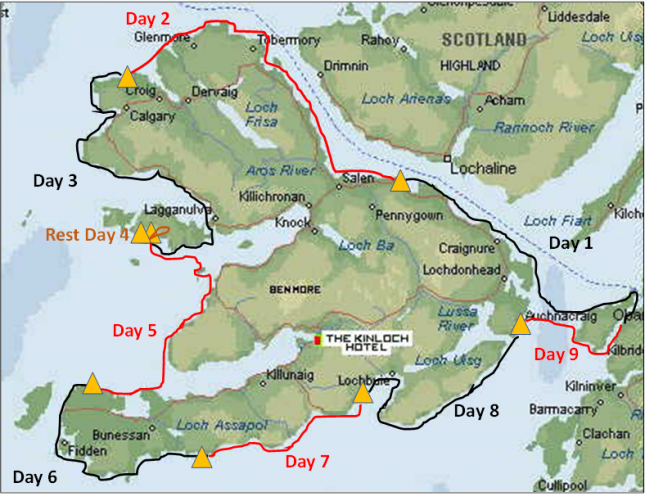
The journey
.
John Willacy has an incredible time for circumnavigating Mull in June 2011 which took 19 hours and 34 minutes and covered a distance of about 148km. No doubt a good bit of tidal planning and weather played some part in this. If anyone out there is interested there is a great website of information: performanceseakayak.co.uk. My solo circumnavigation took 9 days including a rest day and covered 236km – a somewhat different experience. As they say ‘whatever floats your boat’.
My plan grew as the months, weeks, days, hours and seconds of Covid incarceration ticked by. Eventually Lockdown lifted and the weather forecasts looked favourable. Wind indications were that an anti-clockwise route would be best.
Saturday Day 1, 35 Km Oban Bay to Rubha na Leitreach (Fishnish Bay)
A 0500 wake up and 0630 depart from Nethy Bridge meant that the roads to Oban were devoid of traffic. Passing the Falls of Lora at Connel Bridge my sea kayak psyche was building as I clocked that the tide there was flooding. Oban itself was Saturday sleepy. A ghostly Kilbowie Outdoor Centre (now sadly gone) was my point of departure with ski matting providing an easy, kind on the composite kayak, launch pad. With supplies purchased and organised at home I was packed and on the water at 1110. Quiet paddle strokes took me away and within 5 minutes I encountered my first otter. A tail wind pushed me to the North end of Kerrera out of Oban Bay and in my wake I could feel the Covid stressed world disappearing behind me. Around then to Slatach Bay on the west side where I saw another otter and then the mighty mass of a sea eagle. And breathe, phoooooooo…
I chose to cross from Rubha a’ Fhreastaig to Loch Don on Mull. Not really tuned into careful tidal planning for this I found as I neared the Mull coastline there was a fresh south-westerly and the flood tide I had seen at Connel was now ebbing at full flow southwards against the wind. This resulted in an increasingly challenging sea with multiple rogue waves. With a fully laden kayak and some directional handling challenges I had a full on 10 minutes relying on some skilful paddling to remain upright. Not the ideal start to a trip, getting a few unpredicted dousings. ‘Welcome to Mull’ the seas were saying. The rest of the day was calm, if not a little west coast damp.
The proven south-westerly was the key reason my trip began by heading North up the sheltered eastern low-lying coastline of Mull. Markedly different to the west, it has less seriousness and exposure. It was also my intention to get a few good long days, meaning I could get ahead of schedule and have an easier time later.
I paused at Eilean a’ Mhadaidh – Wolf Island, the first opportunity to land and stretch my legs. There I was accompanied by many bemused seals. With a slackening tide, soon to become a helpful one, I passed the William Black Memorial Lighthouse and then a scaffold-clad Duart Castle and the nearby Torosay Castle. A few possible campsites investigated with one lengthy fruitless check out of Bàn Eileanan before finally stopping at Rubha na Leitreach just north of Fishnish Bay. While it was close to the road it was flat, comfy and quiet with a handy picnic bench and minimal distance over which to move kit from the beached kayak to camp. Just the sort of ingredients for an easy life. A dinner of fresh Tagliatelle with an Arrabiata sauce, consumed whilst sat outside, with just enough breeze to remain midge free, ended a long day and led to a sound sleep.
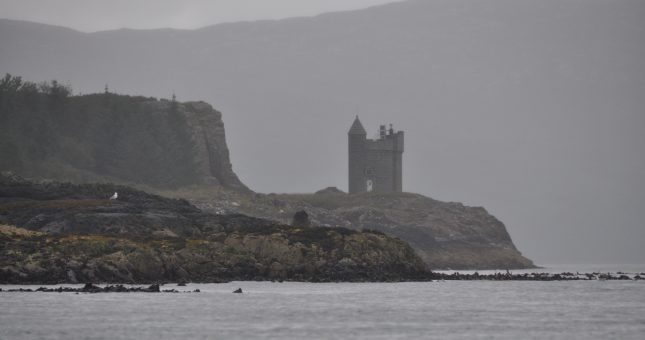
Duart Point Lighthouse, William Black Memorial Lighthouse.
Sunday Day 2, 40km (75km) Rubha na Leitreach to Port Langamull
Everything was going to plan, with the wind playing ball and the calm waters of the Sound of Mull making for a stress free start. With an early but comfortably slow start I was on the water at 0810 to catch the easy launch on a high tide North to Tobermory. It was dry with light winds. More otters and today’s Castle – Aros. It was pleasant enough weather to stop at Kentallen Bay to enjoy a breakfast of sea kayak champions – bacon butty and boiled egg washed down with an aeropress coffee. I spotted a strange looking craft approaching, bow high in the air – it was a solo sea kayaker sitting in the back of a double kayak. As they passed I commented that they were missing someone. Later I saw them leave Tobermory heading south, this time with a second crew member and with things looking way more shipshape.
.
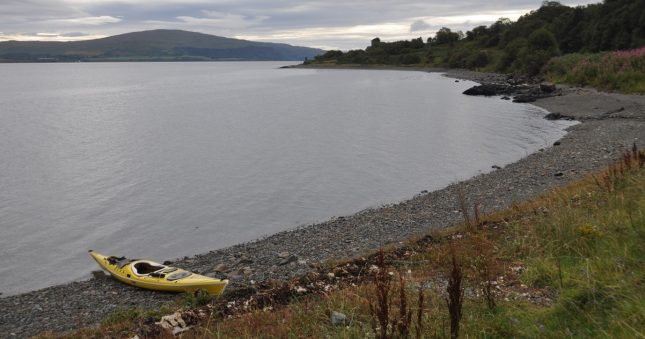
Catching the high tide north from Rubha na Leitreach in the Sound of Mull
.
I had a long break in Tobermory using the marina facilities and picking up my sea kayaking triumvirate of essentials – fresh milk from the Co-op, fresh water from the pontoons and (fresh) whisky from the Tobermory Distillery shop. Well, why not? Whilst there I saw another 5 sea kayakers – a team of 3 and a team of 2 who I then did not see again. Some of them were in dry suits and I remember thinking it was a bit warm for that level of protection.
.
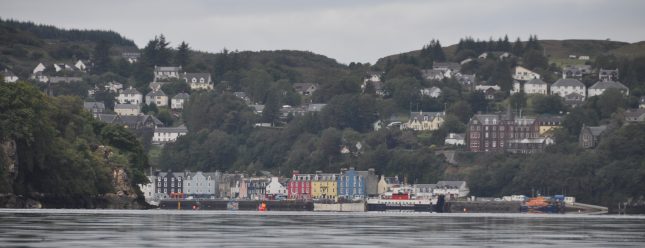
Tobermory
.
Leaving Tobermory and heading North it is not long before Rubha na Gall lighthouse heralds a change in the topography. Cliffs begin and the landscape becomes more rugged and the coastline indented. Another otter sighting close to the lighthouse and then shortly after 3 sea eagles that appeared to be pulling every imaginable manoeuvre in the wind eddies at the cliff tops; perhaps 2 adults educating this year’s youth? Not long after this was Ardmore Point, a key place on the circumnavigation. This is where one commits to the west going North Coast paddle. If there had been strong westerlies here it could well have been a stopping point. My next key place after this would be Caliach Point where I would commit to the south going leg of the west coast but with more route options.
Today the seas at Ardmore were calm and encouraging and the wind a manageable South westerly Force 2-3. What caused an issue now though happened very quickly. Having covered about 36 km and only really having eaten properly at 1000, it was now 1700 and I was feeling the lack of food. I definitely hadn’t eaten enough since my mid-morning breakfast, missing the opportunity in Tobermory as I hadn’t felt hungry at the time. I was over-heating too, which exacerbated things. I needed to stop. Fortunately calm seas and a handy island at the mouth of Loch Mingary gave me the opportunity. Seals once more gazed on as I recovered. Food consumed and a removal of extra layers meant I was back in equilibrium for the remaining 6km paddle into Port Langamull. Approaching at 1830 I saw a woman swimming off the beach where I had planned to land, so not wanting to disturb them I chose a smaller equally sandy beach, which as it turned out, was a shorter carry to a fine camp spot. Once my boat was empty it was an easy trolley too.
.
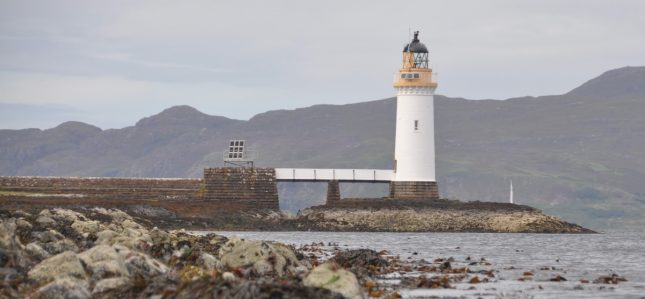
Rubha na Gall Lighthouse
.
I had happened across Port Langamull while researching for my trip. It appeared to fit well for the second night camping spot on my circuit but would require a couple of back to back long days and favourable conditions to make it viable. Needless to say, what a spot. Go find it for yourselves, either as a day trip, one-nighter or on a multi-day. The sunset and sunrise views are outstanding with Rum and Eigg framing the Cuillin of Skye, the swimming is cool and it is far enough from roads and habitation that it is likely you’ll have it to yourself. It is what I call a ‘big sky’ area too, with low lying land making the sky fill all the available space. To be sure though make sure you have brought water with you, as whilst there is some freshwater it is not the cleanest running.
Tagliatelle once more filled my belly and I enjoyed a stunning location and a stunning evening with just enough breeze to keep the midges down.
.

View North from Port Langamull
.
Monday Day 3, 39km (114km) Port Langamull to Tràigh Bhàn, Ulva.
Up early again at 0600 and with a glorious sunrise skinny swim followed by air drying in the vague heat of the morning sun, what better way to start a day?
I didn’t have to depart until 1030 which ensured I caught the south going 1100 tide at Caliach Point (my last time here in a sea kayak had been a few years before after crossing from Coll in flat calm conditions). The wind was steadily Force 2-3 on my nose and remained like that in an attempt to thwart my enthusiasm, all the way to Ulva Sound.
Today’s wild family were otters rolling around in the water. They entertained me for a good 5 minutes before finally becoming aware of my presence on the water. Was it their footprints I had found on the beach at Port Langamull? The now ubiquitous sea eagles appeared again.
.
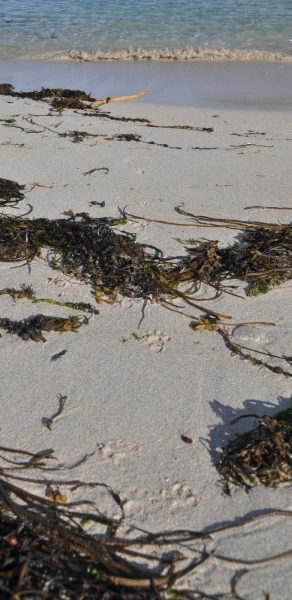
Otter prints at Port Langamull
.
With a warm start I was paddling in just a lycra t-shirt. I stopped at the old pier in Calgary Bay for my champions’ breakfast, somewhat bemused by the hordes of people gathered around the beach and a rammed carpark. Calgary Bay with its large easily accessed sandy beach is a go-to destination for any Mull visitors, quite a contrast to Port Langamull. A wild wetsuit swathed swimmer emerged from the water at the pier then re-immersed for their return swim. I had a novel bow and stern mooring of my sea kayak to keep it afloat and off the rocks on a falling tide.
.
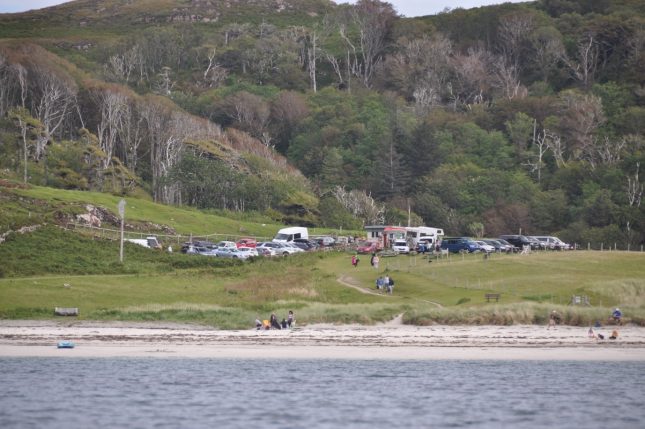
Calgary Bay
.
Leaving the other world of Calgary Bay behind, the way took me around Treshnish Point with views out to the Treshnish Isles, tourist-famed for Staffa and Fingal’s Cave, Lunga with its Puffins and the profile of Bac Mòr – The Dutchman’s Cap – or as my Dad (a retired Cold War submariner) used to say ‘…an Alpha Class Russian submarine’. Turning east into Loch Tuath there were ever changing views to Ben More. I landed briefly at Tràigh na Cille, notable for its good camping potential and its dark silty silvery sand. A couple were there, one bouldering, the other reading a book. We exchanged waves but no words. I picked up fresh water from the burn and as things were beginning to cool down put a cag on. Half an hour later I was taking it off as the weather had turned warm once more. It was great to paddle through the Sound of Ulva which was new to me – an incredibly shallow narrow gap that ensures Ulva remains an island. With my polarising lensed sun-glasses the window shopping into the shallow clear waters kept me entertained as the static world beneath passed swiftly by. On the mainland Mull side of the sound I saw 2 sea kayakers packing up, the first I had seen since Tobermory.
My destination was a wild campsite I had been to before at Tràigh Bhàn on the south side of Ulva, so the last couple of kilometres were familiar territory and I knew I was going to arrive at a fine location and didn’t get tempted to look elsewhere. There was a curious reverberating sound that revealed itself as the generator of a large new fish farm construction. Soon though the sound dispersed and I enjoyed a brisk tail wind among the Ulva archipelago. The camp location was as good as I had remembered, the only disappointments were the obvious and unnecessary fire scarring of the fine machair left by some previous visitors, coupled with disintegrating fish farm debris casting polystyrene balls all over the place, sadly both of which are very common sights around our Scottish coastline.
With strong easterlies forecast for the night and the next day I pitched my tent in a slight depression and then set about collecting firewood. I wandered around barefoot collecting more than just wood. On close inspection my lower legs and feet were left covered with tick larva. Fortunately an application of strong insect repellent saw them all off. As darkness closed the day, the warm glow of a small fire on the beach in the tidal zone gave time for reflection. Satisfyingly in 3 days I had reached my approximate planned half-way point and as far as I was aware the forecast ahead was set to improve my chances of success.
.
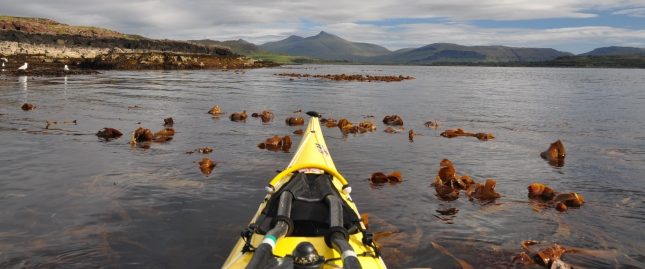
Loch Tuath and Ben More
Tuesday Day 4, 0km (114km)
5km walked
The strong Easterly winds were forecast to reach Gale 8 and with time in hand I decided to spend the day on Ulva. I rewarded myself with a restful lie-in, a cup of tea at 0930 then breakfast of bacon butty, muesli and coffee was taken at 1100. During the afternoon, in the search for fresh water, which I did eventually find but it was a bit of a wild goose chase to get it. It also involved quite a brackenfest, again picking up numerous ticks. To accompany the ticks I also saw red deer hinds, sheep, wheatear and a wren, as well as the so common otter. During this foray I also summited Beinn Chreagach (313 metres), Ulva’s highest point which gave fine views. This filled part of what was a restful day or perhaps it should be called a Mullfull day. The best thing about this day was that I actually had the time to take it in, time to mull, time to slow down, time to press pause, time to not feel any urgency. Nada, nothing, nowt, zilch, real rest, calm, peace, space, time…
Ulva is worthy of special further mention as it had a successful community purchase in 2018. Check out https://www.ulva.scot/ . It did feel this time with Covid being what it was that I should steer clear of visiting the community there. Next time I will drop in…
The wind never did quite reach the strength forecast and with my tent tucked into that slight dip any stronger gusts passed overhead virtually unannounced. The rain set in during the evening and persisted all night but I slept well.
.
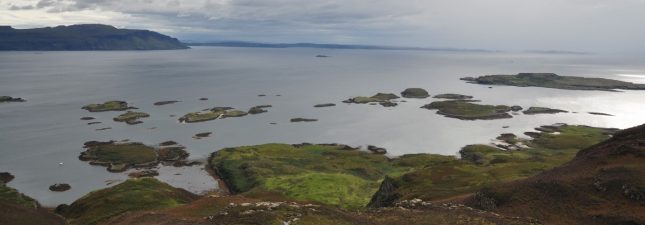
View from Beinn Chreagach, Ulva
.
Wednesday Day 5, 28km (142km) Ulva to Tràigh na Margaidh
Wonderful wildlife…
My diary entry for this day began ‘Rain. More rain. And then some more…’. A very wet Wednesday morning delayed my departure. By 1100 it had ceased and I packed in the dry clearing skies and the warmth of the windless day increased. It remained so, all day sunny and Force zero. Overdressed at first as I paddled the coast-line I gradually stripped down my layers to once more be left paddling in just a lycra t-shirt and shorts.
My first wildlife encounter was an otter as I left the campsite, not long after were the seal on Inch Kenneth, followed by feral goat in abundance. I then saw a team of 4 sea kayakers who were making a bee-line for Staffa.
The Ardmeanach peninsular of Mull is remote and uninhabited. It aptly has an area called ‘The Wilderness’, a haven for wildness where I saw waterfalls, cliffs, feral goat, deer, otter, leaping sea trout and some geologists looking for the famed fossil tree which is easily seen from the sea but a real mission to get to from the land. Many paddlers miss out this area on their circumnavigations favouring the Treshnish Isles instead. With plenty of time I stopped for lunch in the heat of the day on a large stoned beach. Whilst there another chocolate otter surfaced and then silently melted away.
.
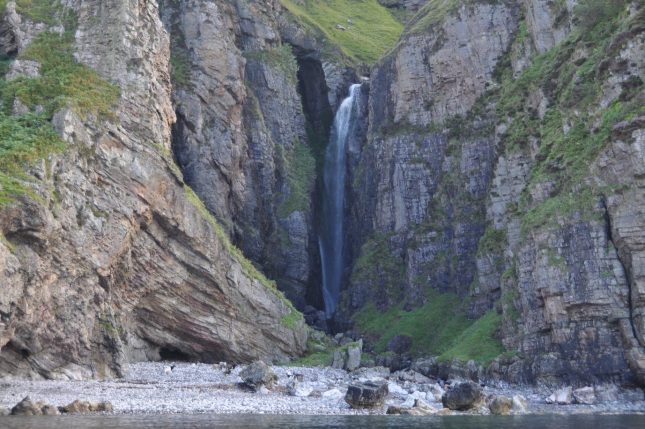
Ardmeanach Peninsula. Spot the Goats
.
Leaving Ardmeanach after lunch with a south heading across Loch Scridian toward the Ross of Mull I saw a pair of peregrine and spied their coastal refuge. The wildlife rewards kept giving and at Tràigh na Margaidh I watched some young razorbills herding shoals of sandeels in the shallows. I was just a few metres away on the sandy shore and it was a very entertaining spectacle. This was also my chosen camp area and after a good bit of checking around for good sites it was only after pitching my tent that I noticed the local colony of solitary mining bees and in a stream bank just a few metres away, the sand martins’ nests.
.
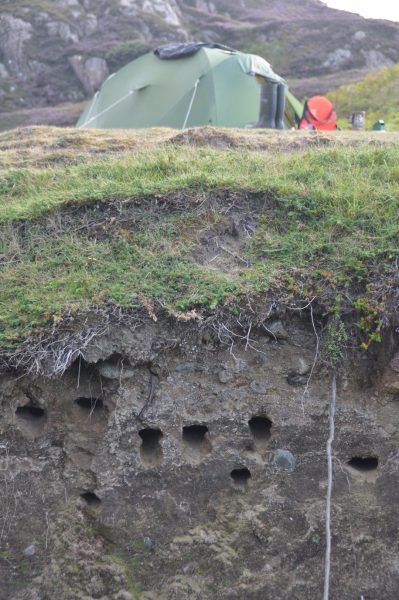
.
I had another great skinny swim in the sun followed by a sunset dinner, again just enough breeze to suppress the local midges enthusiasm.
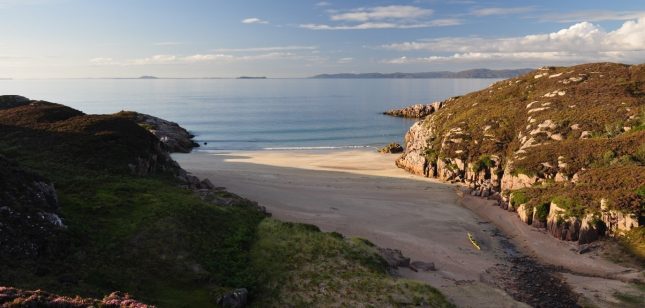
Tràigh na Margaidh, looking North
.
Thursday Day 6, 30 km (172km) Tràigh na Margaidh to Tràigh Bhàn na Sgùrra.
It was a pack between showers morning. The young razorbills were having fun in their nursery again and the peregrine paid the beach a visit. The bees and martins remained active too.
It was also to be a bit of a crux day, what would the South West of Mull bring along with the new easterly swing of the compass heading? Departing at 1030 I paddled at a leisurely pace planning to pick up the tide later. On the way to Fionnphort (port of the white sands) I met Erin Bastien (who I knew from working at Glenmore Lodge) with a team doing a half Mull trip, we had a quick chat and I left them as they continued heading North.
The 1 ½ hr stop at Fionnphort was planned as a resupply point and fortunately the Spar gave me the fresh milk, bread rolls and bacon that I was after. Everything else there was shut due to Covid times. It was there that, just as I finished my lunch, the rain began and kept on for the rest of the day. It gradually cooled me down enough to warrant putting on more layers and pulling out my pogies. I then got too hot!
Rounding the island of Erraid and in a choppy sea I met a couple of other paddlers out for a trip from Fidden campsite on a thwarted mini circumnavigation of the small isle. With neap tides the route was unnavigable, even in a sea kayak, the shallow water between the island and Mull meant they had to retrace their strokes.
Hobby horse alert: On the south shores of the Ross of Mull I checked out a couple of remote beaches for camping and was shocked by the collection of rubbish. Much of it was embedded among the rocks and in the vegetation. The other ‘blight’ in these otherwise idyllic spots is often the prevalence of livestock and their associated decimation of vegetation and their organic deposits. As there is not much, if any, grazing in these locations anyway it is not as if they would be losing out by fencing them off which would give some environmental protection. I also often wonder how high the associated health hazard to humans is. Wildlife encounters continued and I sat in my kayak 50 metres away from a sea eagle enthroned on a rock watching me watching it watching me. Either that or it was eying up the abundant and tasty looking shags.
.

.
Toward the end of the day the easterly wind slowed progress and drove the dampness of the rain deep into my additional thermal layers, and with that a cooling of my core. At 1730 I finally found a fine camp spot among the livestock and litter at Tràigh Bhàn na Sgùrra. There, once pitched up, having worn the same clothes for 6 days, now I did finally dig out some clean dry thermal layers that instantly warmed me up and led to a comfortable night. Looking beyond the immediate rubbish it was a stunning spot.
That evening a soup and a tasty couscous vegetable medley ensured I was well fuelled, a real instant winner.
.
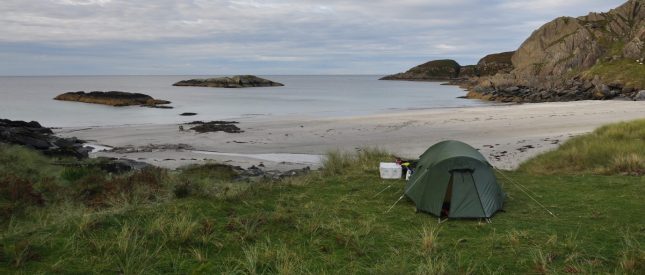
Tràigh Bhàn na Sgùrra
.
Friday Day 7, 23km (195km) Tràigh Bhàn na Sgùrra to Port Donain.
When one reaches 3 or 4 days into a trip the routine generally sets in and life seems simple. On day 7 now, I felt balanced and relaxed, the forecast for the remaining exposed coastline of Mull was excellent, sheltered and dry with North Easterlies. There was more stunning wildlife – including multiple eagle sightings – and coastline all the way into Loch Buie and a surprise camp at Glenbyre. Deciding early to only paddle a short way gave me time to do so, and so it was the way. Wildlife and scenic encounters insisted on slow paddling.
Two huge sea eagles appeared at Rubha nam Bràithrean – Brother’s Point (perhaps they were?) one right above my head and proceeded to soar higher and higher over the sea. Later I saw another and then another this time a Golden Eagle dwarfing the mobbing hoodies. Peregrine, sparrowhawk and kestrel, many seabirds and a constant heron presence. Many more gangs of seaweed munching feral goats were spread along the shingle shoreline, I joined some of them for lunch at the Carsaig Pillars.
.
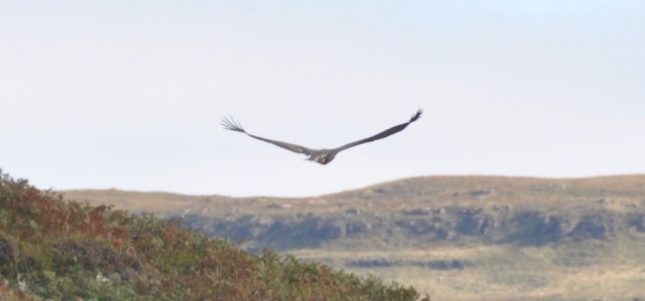
Sea Eagle
.
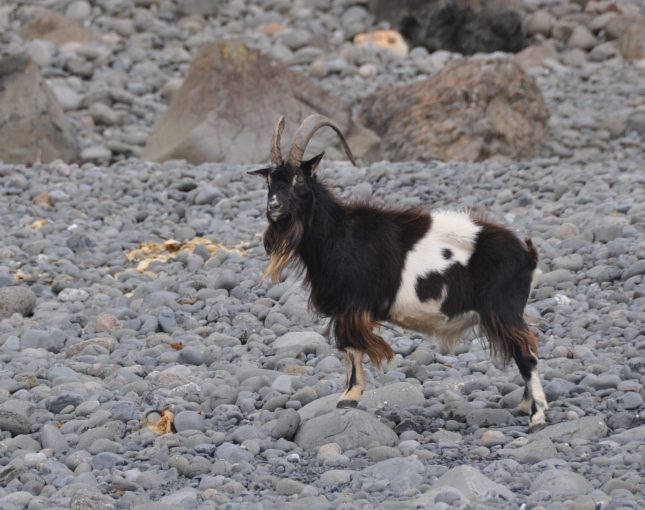
Feral Billy
.
The coastline kept on giving, one note I made in my diary reads: “Along the coast were many spectacular waterfalls – people stop in car and bus loads to see small waterfalls. These could stop a city!”
The complex crumbling coastal geology of massive landslips and rockfall with enormous impact marks on steep grassy slopes left me wondering how often the wild animals were hit. Basalt gave way to an area of sandstone cliff, what other forces had been at work?
The ‘accidental’ camp spot at Glen Byre was excellent, flat grass, freshwater and fine views all supported by a helpful breeze. I couldn’t have planned it better. Arriving early at 1530 gave me loads of time. I wandered up the river and found the best pool in the sun for a fittingly freshening wash. Just the best after 7 days with 2 salty swims. Before darkness fell I watched gannet going busily about the bay in a helpful fresh wind and later ended the evening with another small beach fire savouring and toasting the solitude and my luck with some of Tobermory’s nectar.
.
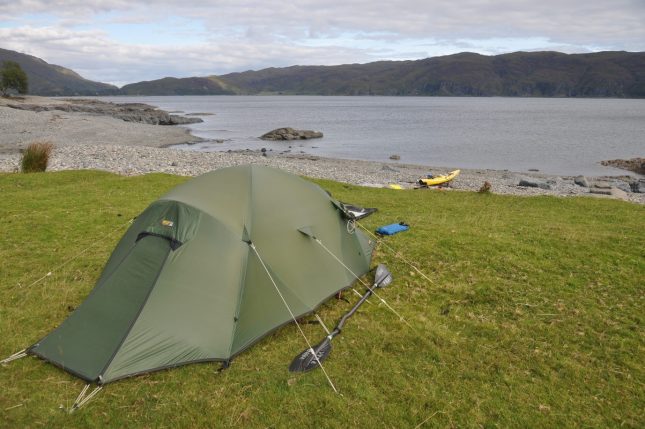
Glen Byre Camp
.
Saturday Day 8, 28km (223Km) Glen Byre, Loch Buie to Port Donain.
Up at 0700 with the sun beaming into my tent it was a fine start to the day. I had time on my hands now with forecast good weather that would see me to the end. I left camp at 1115 and contoured the coast of Loch Buie. I was surprised to see what appeared to be ‘hundreds’ of people milling around the village Lochbhuie and Moy Castle, unsighted from my secluded camp spot just 2 kilometres away. I since discovered the village is quite a tourist hotspot with plenty to see and do. After an hour I rounded Rubha na Faoilinn and the oddly named (it is out of sync with all the other Gaelic names) Lord Lovat’s Bay and Frank Lockwood’s Island. More majestic cliff-lines towered over me and numerous pairs of hind with calf dotted the grassy hillside.
.
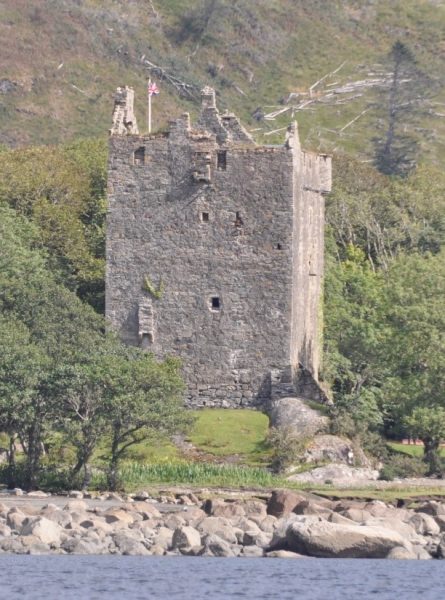
Moy Castle
.
I found a nice landing at Port Ohirnie where I refuelled and prepped for the final coast and paddle across to Kerrera. Just after this lunch the sea eagles showed themselves again, one in the air and this time one on the ground. Approaching Loch Spelvie a few kilometres up the coast I again spotted two more and shortly after a golden eagle. Kestrel and sparrow hawk added to the menagerie and not to be outdone an otter surfaced right beside me.
My plan had been to paddle across to Kerrera and camp at a spot I know there. However a brief investigation – following the eagle sighting – of Port Donain, found camping that I just could not turn down. Just the best spot. There was a fresh North wind blowing down the Firth of Lorne and the next day’s forecast was for lighter winds, I took the gamble. It was meant to be. The landing here was on soft sand and it enabled a short trolley right to the spot where I would camp. So easy. It also meant I could use the kayak as a wind break and sit in shelter to cook and relax. It was a fine spot to mull over the trip and watch the sun set on the hills of Lorne.
.
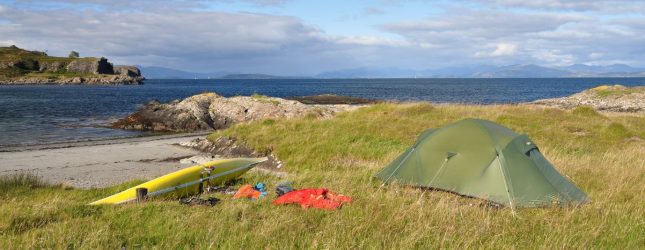
Port Donain
.
Sunday Day 9, 13km (236km) Port Donain to Oban Bay
I rose at 0630 and was on the water at 0720, but not before a buzzard and another eagle had cruised by dwarfing a small tree as it alighted in its branches.
As expected it was a super calm crossing to Kerrera. Arriving at the south end it was notably busy with yachts and a camp of sea kayakers, glad then I was, that I had favoured the Port Donain camp. Appropriate to the circumnavigation to have spent my last night on Mull, the whole situation left me with a contented glow.
My final strokes carried me back up the sound of Kerrera to the stark remains of Kilbowie. There I met and chatted to an instructor who had served 26 years there and just been made redundant – he had just negotiated one of the centre’s Drascombe sailing boats to be handed to the local sailing club – at least there it’s life would be continued and Kilbowie’s legacy would carry influence for a while yet.
All that remained was for me to rack and pack; and so end another outstanding journey into the unknown. The car journey home was unhurried and gave one more time to mull the last nine days. I had a smile all the way home.
.
About Giles Trussell
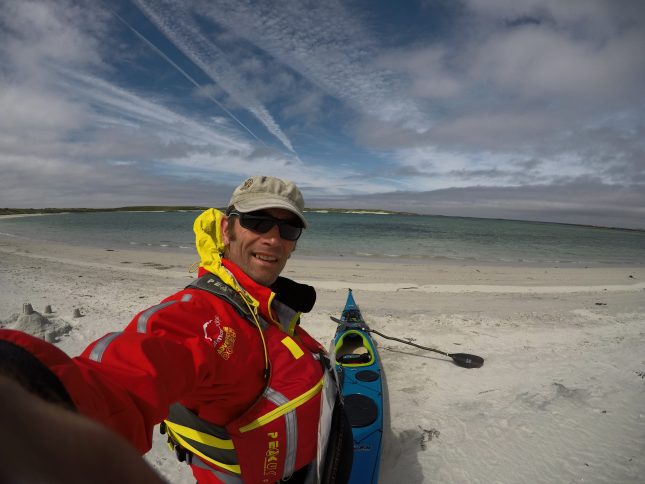
.
Fortunate to paddle from an early age and live close by the sea (50 metres from the high water mark) sealed Giles’s future love of sea kayaking. Spring tides were already understood at the age of 11 when he used look for – and find – lost fishing tackle on the shores of the Gareloch – low equinoxial spring tides being the best.
In 1996-97 he had a ‘transformational year’ while on a 13 month Atlantic Circuit in a 9 metre yacht, sailing with one other person.
A few years on and as well as a passion for all things canoe and kayak, sea kayaking exploits have taken him around many of Scotland’s Islands, often solo. He has enjoyed numerous sea kayak expeditions around the world including Southern Greenland, the Mediterranean and an epic circumnavigation of Stewart Island in New Zealand with a friend in 2010. That year only 3 people completed the circumnavigation.
In 2018 he realised a long term ambition to solo sea kayak to St Kilda…and back again.
Most recently in 2020, in between lockdowns, he had the fortune to enjoy a leisurely 9 day solo expedition around the Isle of Mull.
For sea kayaking – he says – “Scotland is as good as it gets anywhere in the world.”
Giles helps deliver the Glenmore Lodge paddlesports programme. For more details about sea kayak expeditions and skills courses, visit our website.